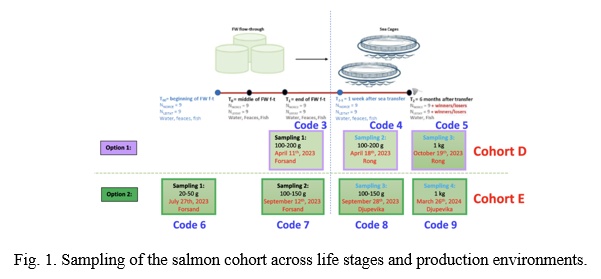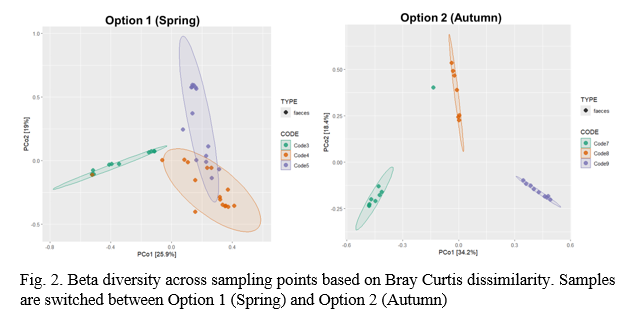EFFECT OF SEASON AT SEAWATER TRANSFER ON ATLANTIC SALMON GUT MICROBIOME AND ITS INTERACTION WITH PERFORMANCE IN FLOW-THROUGH SYSTEMS
Introduction
Seawater transfer (SWT) represents a critical phase in Atlantic salmon aquaculture, often accompanied by high stress and susceptibility to infections, which are influenced by various environmental factors, including seasonality. The gut microbiome is essential for fish health, influencing digestion, immunity, and barrier functions. Nevertheless, the impact of the season at seawater transfer on microbiome composition and subsequent fish performance in flow-through systems remains understudied. This research investigates seasonal effects (spring vs autumn) at the time of SWT on gut microbiome dynamics and their implications for salmon performance.
Materials and methods
Atlantic salmon smolts were transferred from freshwater to seawater during two different seasons: spring and autumn. Sampling occurred at multiple timepoints: just before SWT (Code 3 for spring; Code 7 for autumn), one week after SWT (Code 4 spring; Code 8 autumn), and six months post-transfer (Code 5 spring; Code 9 autumn). Feces samples were collected from the posterior intestine, and genomic DNA was extracted. Microbiome composition was assessed via 16S rRNA gene sequencing (V3-V4 regions), using Illumina technology. Bioinformatic analyses included quality filtering, ASV assignment (DADA2), taxonomic classification (SILVA138.1 database), and diversity analyses (Shannon and Bray-Curtis indices).
Results
Gut microbiota showed significant seasonal differences at seawater transfer, with higher microbial diversity observed during autumn compared to spring (Shannon index, p<0.05). In spring-transferred smolts, low diversity correlated with increased abundance of the genus Brevinema. Bray-Curtis analysis indicated distinct microbiota compositions between seasons (MANOVA, p.adj < 0.001), suggesting a more specialized microbiota over time in autumn cohorts. At later stages, Malacoplasma emerged as the dominant genus in both seasonal cohorts. Furthermore, specific taxa such as Photobacterium and Carnobacterium varied significantly between seasonal transfers, implicating potential functional implications for fish health.
Discussion and conclusion
Our findings indicate clear seasonal effects on gut microbiome composition at seawater transfer, with autumn transfers supporting higher microbiota diversity and specialization. Such microbiota differences may underlie differential performance outcomes and disease resistance. Seasonal variation in microbial communities underscores the importance of considering environmental timing in aquaculture practices. Future studies should investigate functional implications and potential microbial biomarkers such as Brevinema for optimizing salmon production in flow-through systems.
Acknowledgments
This project has been funded by BlueRemediomics -Grant No.101082304, EU Horizon Europe Programme 2022. Fish were sampled from Lerøy´s land and sea facilities in Norway.

